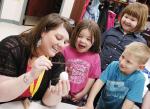LEWISTOWN, Mo. – Nothing says spring like the cheep of a baby chicken.
For more than five decades, elementary students in Missouri classrooms have flocked around 4-H specialists to learn the science of embryology. University of Missouri Extension 4-H youth program assistant Katie Hogan recently hatched up “eggs-citing” presentations for students in 26 classrooms in Lewis and Clark counties.
Eggs delivered to classrooms in Hogan’s area are among 1,500 dozen (or 18,000) eggs distributed by 4-H specialists statewide annually, according to 4-H specialist Ben Gallup.
Each participating class receives a dozen fertilized eggs that have been candled and pre-incubated for two weeks. 4-H staff set up incubators in the classrooms of teachers who have completed the national 4-H embryology curriculum. Teachers, day care providers and others pay the cost of the eggs and assume responsibility for turning eggs daily.
For seven days, students watch and listen. They hush and bend their ears to the incubator as chicks peck their way into the world.
Hogan said 4-H promotes learning about STEM (science, technology, engineering and math) subjects and this hands-on experience engages students in those areas.
“The embryology project integrates very well into 4-H’s STEM commitment. It’s more than a hatching project,” said Jesse Lyons, poultry specialist with MU Extension. “Biology is a science, and they also learn about engineering and technology through working with the incubators.”
A Tufts University study shows that young people involved in 4-H do better academically and are more likely to go to college than peers who aren’t in 4-H. They are twice as likely to participate in STEM learning programs.
Hogan said students learn the importance of planning and organizing, record-keeping and teamwork, observation and safety. They also learn the value of timing and patience. They feel joy when the eggs hatch and disappointment when some don’t. The adage “Don’t count your chickens before they hatch” takes on new meaning.
Hogan meets with students in every classroom for “breakout” sessions. She reads a book to them about chickens and then shows them a set of life-cycle eggs – plastic replicas that show a cross-section of an egg as it develops into a chicken. She dissects an egg, explaining what each part plays in the nourishment of the unborn chick.
Velynda Cameron, a specialist in Polk County, takes empty eggshells from an ostrich, rhea, turkey, duck and hen to show the class. She shows them how small a hummingbird’s egg is through Tic Tac breath mints, and then shows them a honeydew melon to illustrate the size of an ostrich egg.
The Missouri 4-H embryology classroom goes back to the 1960s, when retired extension poultry specialist Glenn Geiger of Columbia started the incubation project modeled after a similar extension project in New York.
He and other extension specialists built incubators and trained teachers and staff. Geiger, now 90, said the project involved everyone at the school from the janitorial staff to administration. “We learned as we went along,” he said. “Everyone was so excited about it.” The program proved to be extremely popular, especially in inner-city areas where they could take the farm to the city.
Poultry continues to be a popular project choice for Missouri 4-H’ers, Gallup said. There are 1,258 members enrolled in poultry projects statewide.
The MU Extension Center in Adair County lists resources and fun experiments for parents and educators on its website at extension.missouri.edu/adair/schoolenrichment.aspx.
Read more http://extension.missouri.edu/news/DisplayStory.aspx?N=2148





